Hoi An attracts millions of visitors every year to its centuries-old relics, nights that are magically lit up by hand-made lanterns, and gentle activities like cruising on the Hoai River that flows through it. This old town in the central province of Quang Nam is also known for its people’s honesty and hospitality.
But Hoi An’s attractiveness also lies in its vast cuisine with foods that are cheap — not more than VND 50,000 (US$2.3) for a dish — but delicious. Moreover, food of decent quality can be found even in street stalls and small eateries.
If you plan to make a food tour in Hoi An, it is highly recommended to start at around 3 p.m., when motorbikes are restricted, leaving streets free to pedestrians and a few bicycles and tricycles. It is also the peak time for street food vendors. And remember to add the following foods to your list.
- Mi Quang
Literally translated as Quang (Quang Nam)-styled noodles, mi Quang is popular around the country, even among foreigners. It is recognizable with its thin, flat rice noodles glazed with a mixture of peanut oil fried with onion and usually yellow broth.
It is recognizable with its thin, flat rice noodles glazed with a mixture of peanut oil fried with onion and usually yellow broth.
Traditionally, its main ingredients are shrimp and pork, which are also used to cook the broth and astoppings together with peanuts and rice crackers. But the dish has gradually become diverse with more toppings like chicken, fish, squid, eggs, snails, and even frogs.
Many Vietnamese foodies prefer Hai, a small eatery at 6A Truong Minh Luong Street.
They also recommend a street stall on Nguyen Hue Street, saying it sells the dish in its original version known as mi Quang Phu Chiem. The dish is named after a Quang Nam village believed to be its birthplace.
- Cao lau
Cao lau is a rice noodle believed to have been invented in Hoi An. It is equally delicious but, for some reason, less popular than mi Quang.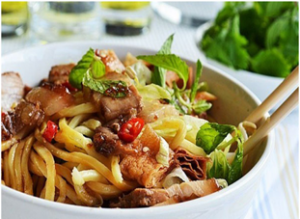
In a way it has some things in common with Chinese and Japanese noodles. Its al dente noodles, for instance, look raw and thick like Japanese udon. Its toppings include slices of pork that look like char siu or Chinese barbecued pork.
Cao lau is eaten with lots of herbs and vegetables which greatly enhance its flavors.
One of the best places for cao lau is a food stall named Ba Be in a market opposite Ong Temple. Le Ba Truyen Restaurant at 12 Ba Trieu is also said to sell original cao lau.
- Com ga
Com ga, or chicken rice, is not exclusive to Hoi An, but locals have successfully improved on it, making it one of their signature dishes.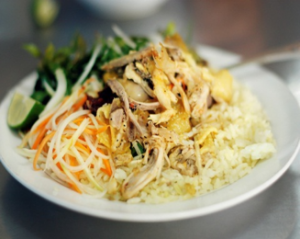
A dish of chicken rice is mouth-watering with its pleasantly yellowed rice topped with hand-shredded chicken and herbs. It is served with a small bowl of soup containing some chicken giblets like heart and liver.
It is said that to make the famous com ga, Hoi An people carefully choose rice and chicken of top quality. They season the rice before cooking it with chicken broth and pandan leaves on wood-fired clay ovens.
The most highly recommended com ga eateries are Ba Buoi at 22 Phan Chu Trinh Street and its next-door neighbor Ty. A street stall on Le Loi Street, named Huong, is also said to be good.
- Banh bao – banh vac
The famous dish actually consists of two kinds of steamed rice dumplings.
Banh vac is filled with ground shrimp, garlic, spring onion, lemon grass, and spices. Banh bao, on the other hand, has minced pork and mushrooms as the main fillings.
They are known –somewhat poetically — as white roses among English speakers, though only one of the two dishes lives up to the name; the other looks more like Chinese jiaozi or pot stickers.
The dish is served with a dipping sauce made from shrimp broth.
For the best dumplings, you have to visit Bong Hong Trang (White Rose) on Nhi Trung Street, where you can also see how the trademark dish is made.
- Banh dap
Literally translated as cracked/smashed rice pancakes, banh dap is perhaps one of the simplest foods in Hoi An’s cuisine, but its contradictory textures easily makes the biggest impression on foreigners.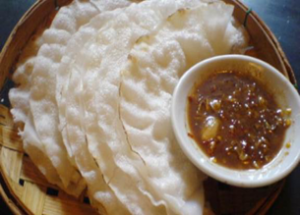
Banh dap is actually a combination of two kinds of rice papers, one white, thin and kind of sticky and the other, dry, crispy and brittle.
Even though the dish looks very simple, you have to learn some rules to eat it in a right way.
First, you place a wet pancake on a crispy one. Then apply some mung bean paste and place some fried chopped shallots and shredded spring onion. Lastly, add another dry pancake before breaking the sandwich with the hand.
You have to crack the sandwich once again, this time into two, and dip it into a sauce whose ingredient is mam cai — a kind of fermented and salted fish paste that is native to the central region.
A good eatery to check out the special pancake is Ba Gia, which is located in Hamlet 1, Cam Nam Commune.
- Bánh Bèo
Hoi An’s banh beo (steamed rice pancake) is big and thick compared with its Hue cousin. Its topping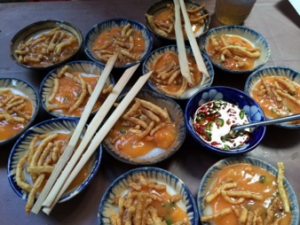 sauce is also thick, and brick red, a color that comes from achiote or tomato juice added to a mixture of shrimp and pork.
sauce is also thick, and brick red, a color that comes from achiote or tomato juice added to a mixture of shrimp and pork.
Some sellers add sugar when mixing the flour to make the cakes, and so they are slightly sweet. The idea of sweet combined with the salt and spice of nuoc mam (fish sauce) – the dipping sauce – might turn some people off. But the fact is that many people are hooked after the first bite.
The town’s banh beo also tastes fatty thanks to fried shallot slices, oil and deep-fried cao lau noodles that are used as another topping.
The distinctive pancake can be found everywhere in Hoi An, but the best is often at street vendors’ and little eateries
- Hoành thánh
If you think you are familiar with hoanh thanh, a Chinese dumpling known as wonton, you may have to think again when eating it in Hoi An,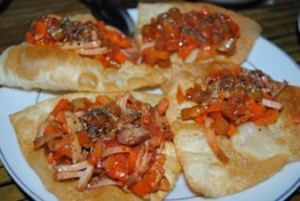 where people make changes here and there so that the popular dish’s flavors become distinct.
where people make changes here and there so that the popular dish’s flavors become distinct.
Like in many other places, hoanh thanh there is served with soup, with or without noodles, or deep-fried.
It is the crispy variety that proves how skillfully Hoi An people can add their signature to non-native foods. The hot shrimp dumplings are topped with a kind of slightly sour and spicy sauce consisting of shrimp, char siu pork, and crispy vegetables.
You can get good hoanh thanh at Anh Dung eatery at 14 Ba Trieu and Van Loc at 27 Tran Phu
- Bánh Mì
Many people consider Ho Chi Minh City the center of banh mi (Vietnam sandwiches) universe since there are myriad choices of filling. However, Vietnam’s best sandwiches are found in Hoi An,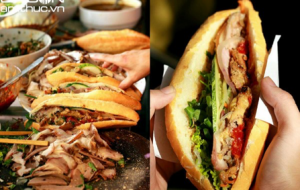 at least according to American celebrity chef and TV personality Anthony Bourdain.
at least according to American celebrity chef and TV personality Anthony Bourdain.
Thanks to his endorsement, Phuong Bakery near Cam Bridge, which sells the best banh mi, is always crowded with foreign tourists.
But ask locals and you will be shown many other stands that sell equally good sandwiches, like a street stall on the sidewalk outside 115 Tran Cao Van Street.
Or, if you prefer different fillings rather than the traditional mix of pâté, pork, cha lua (kind of pork bologna), vegetables, and sauces, you can check out banh mi stuffed with roasted pork at Minh Thu bakery at 248 Ly Thuong Kiet Street….
- Banh cuon thit nuong
Banh cuon thit nuong, or wet pancake rolled with grilled pork, is a common dish at restaurants that serve central region foods, including from Hue. However, while in Hoi An, you should ch eck out street stalls along the Hoai River.
is a common dish at restaurants that serve central region foods, including from Hue. However, while in Hoi An, you should ch eck out street stalls along the Hoai River.
The dish is served on a tray consisting of a stack of wet rice pancakes, skewers of charcoal-grilled pork, a dish of fresh herbs and vegetables, and peanut sauce as a dip.
With this you can make the rolls by yourself. And do no worry that your rolling skills may be sloppy: who cares how it looks when the food is exceptionally good?
- Bánh Xeo
The fried rice pancake is not a must-eat in Hoi An but still worth checking out during a food tour.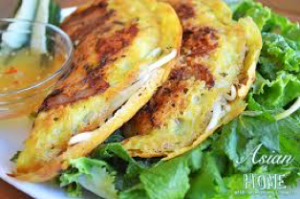 The “sizzling cake,” as it is known among English speakers, is quite popular there, especially during the rainy season.
The “sizzling cake,” as it is known among English speakers, is quite popular there, especially during the rainy season.
Unlike its cousin in many other places, Hoi An banh xeo is mainly stuffed with shrimp rather than pork or beef. Other fillings are hulled mung bean and bean sprout. It is also smaller, especially when compared with the southern version.
Banh xeo is served hot with a lot of herbs and green vegetables.
Many foodies recommend Ba Le Well Restaurant at 45/51 Tran Hung Dao Street for good banh xeo.
- Chè Bắp
A food tour in Hoi An is never complete without sweet beverages,  dessert soups and puddings that are collectively known as che in Vietnam. Che in the ancient town comes in small bowls that cost just a few cents at street stalls.
dessert soups and puddings that are collectively known as che in Vietnam. Che in the ancient town comes in small bowls that cost just a few cents at street stalls.
Whether or not you have a sweet tooth, make sure to check out the local sweet corn soup or che bap, especially the one made with corn grown in Cam Nam Ward, considered among the country’s best.
Che bap can be eaten hot, cold or with another sweet soup.


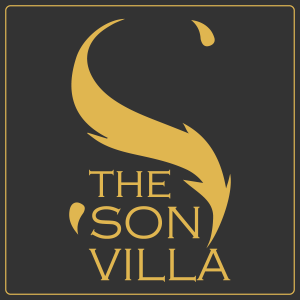

 It is recognizable with its thin, flat rice noodles glazed with a mixture of peanut oil fried with onion and usually yellow broth.
It is recognizable with its thin, flat rice noodles glazed with a mixture of peanut oil fried with onion and usually yellow broth.



 sauce is also thick, and brick red, a color that comes from achiote or tomato juice added to a mixture of shrimp and pork.
sauce is also thick, and brick red, a color that comes from achiote or tomato juice added to a mixture of shrimp and pork. where people make changes here and there so that the popular dish’s flavors become distinct.
where people make changes here and there so that the popular dish’s flavors become distinct. at least according to American celebrity chef and TV personality Anthony Bourdain.
at least according to American celebrity chef and TV personality Anthony Bourdain. is a common dish at restaurants that serve central region foods, including from Hue. However, while in Hoi An, you should ch eck out street stalls along the Hoai River.
is a common dish at restaurants that serve central region foods, including from Hue. However, while in Hoi An, you should ch eck out street stalls along the Hoai River. The “sizzling cake,” as it is known among English speakers, is quite popular there, especially during the rainy season.
The “sizzling cake,” as it is known among English speakers, is quite popular there, especially during the rainy season. dessert soups and puddings that are collectively known as che in Vietnam. Che in the ancient town comes in small bowls that cost just a few cents at street stalls.
dessert soups and puddings that are collectively known as che in Vietnam. Che in the ancient town comes in small bowls that cost just a few cents at street stalls.
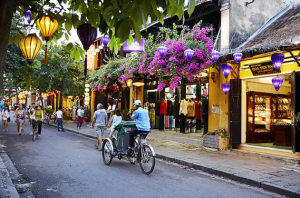
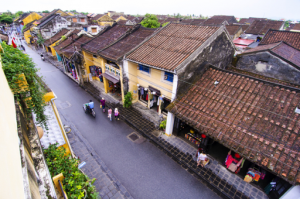
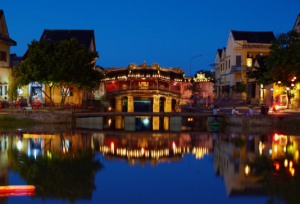

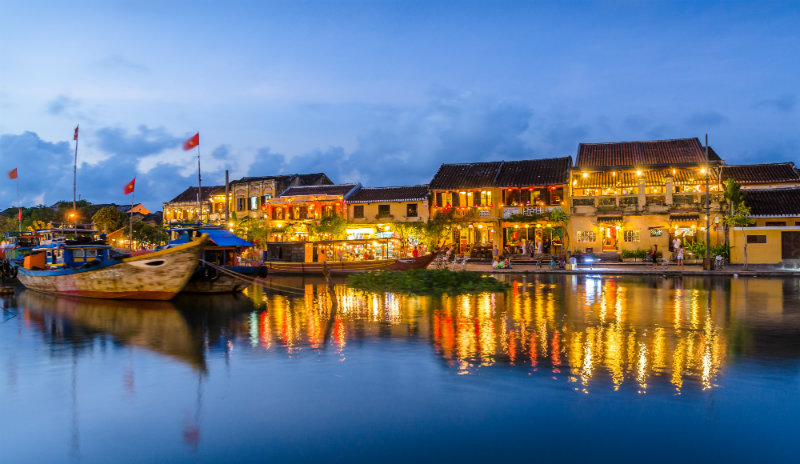
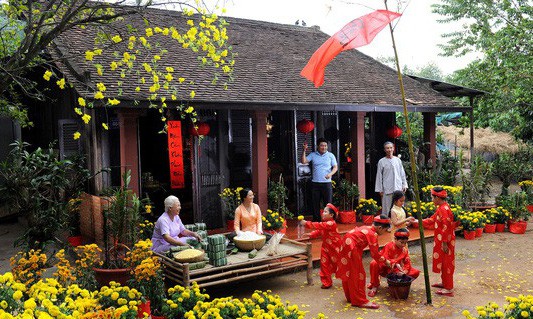
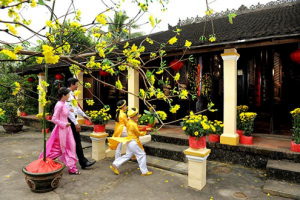 Tet Nguyen Dan
Tet Nguyen Dan
Phản hồi gần đây